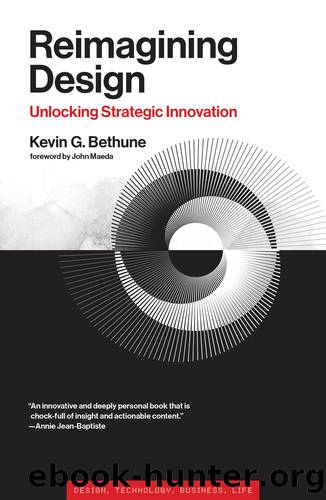Reimagining Design by Kevin G. Bethune

Author:Kevin G. Bethune
Language: eng
Format: epub
Tags: Design; Business; Creativity; Curiosity; Diversity, Equity and Inclusion; Uncertainty; Multidisciplinary; Innovation; Collaboration; Foresight; Leadership; Design Thinking; Human Centered; Systemic Injustice.
Publisher: MIT Press
INNOVATION
Not to be cliché, but letâs entertain the Merriam-Webster Dictionary definition of the word innovation:
1:â â a new idea, method, or device
2:â â the introduction of something new2
Based on a multitude of readings, academic explorations and professional experience, most agree that innovation should be more than just an idea itself. For me, innovation represents bringing a new thing into the market with commercial success across a few different dimensions. We spoke of these dimensions in chapter 3 as desirability, feasibility, and business viability. It is worth reinforcing the basic questions around these terms. First, does the new offering draw interest from the intended audience? Is it desirable to them? Does it matter to them? Second, does the new offering evoke a monetization approach that will garner financial rewards? Will it make money? Will it help us capture more market share? Will it help solidify some degree of competitive advantage. We need the innovation to matter to our bottom line and our strategy at hand. Third, how tough will the new thing be to create? How difficult will the work be? In other words, is it technically feasible to deliver the offering along a specific timeline? What will it really take to build and deliver? Do we need experts in specific technologies? Do we need to license intellectual property to fill a void in the puzzle? Lastly, how does the innovation shape an ecology or the effects on a larger system beyond the offering? This was brought home for me during my time at GradID under Andy Ogdenâs tutelage on dissecting ecologies and amplified by helpful guidance of the likes of Craig Walmsleyâs Impact Canvas.
Before getting too deep into the systematic or ecology-driven implications, letâs get back to the ânew thingâ weâre actually creating. I remember Andyâs coaching during GradID studio assignments. I, along with my classmates, would fall into the trap of splitting hairs about the strategy and the framing of our ideas in the spirit of desirability, viability, and feasibility, but we didnât actually tell anyone what the actual thing we were working on was or how it was embodied. We failed to explain the what. Andy likened our work to moviemaking. We spent so much time on the trailer, prequels, and sequels that we forgot to direct and produce the damn movie. âTell me the movie. What is the movie? Show me the movie.â I probably couldnât appreciate Andyâs consternation in the heat of the academic journey as a wobbly kneed creative. But after some time exercising those skills within global enterprises, I get it now. Andyâs movie analogy actually distills the point quite clearly. We need to evoke a central story of a personâs experience that represents the new idea. What story are we telling? Is it an interaction between human beings? Is it an interaction between a human and a machine? Is it a machine-to-machine interaction that emulates some desired trait of interactive behavior? What story are we telling, and what medium will be necessary to fully embody that story?
Download
This site does not store any files on its server. We only index and link to content provided by other sites. Please contact the content providers to delete copyright contents if any and email us, we'll remove relevant links or contents immediately.
| Decorative Arts | Design History & Criticism |
| Furniture Design | Industrial & Product Design |
| Interior & Home Design | Jewelry Design |
| Textile & Costume |
POP by Steven Heller(3327)
Japanese Design by Patricia J. Graham(3139)
The Power of Broke by Daymond John(2936)
Architecture 101 by Nicole Bridge(2783)
Indistractable: How to Control Your Attention and Choose Your Life by Nir Eyal(2360)
Fusion 360 for Makers by Lydia Sloan Cline(2336)
Batik by Rudolf Smend(2155)
Actionable Gamification: Beyond Points, Badges, and Leaderboards by Yu-kai Chou(2141)
Origami Art by Michael G. Lafosse & Richard L. Alexander(2081)
Homebody by Joanna Gaines(2050)
Whiskey in a Teacup by Reese Witherspoon(1957)
Worn in New York by Emily Spivack(1946)
Feng Shui by Stephen Skinner(1918)
Austin Kleon by Steal Like an Artist(1907)
Simple Gatherings by Melissa Michaels(1884)
Don't Make Me Think, Revisited: A Common Sense Approach to Web Usability by Steve Krug(1842)
Ryan Korban by Ryan Korban(1736)
Hygge: The Danish Art of Happiness by Marie Tourell Søderberg(1711)
The Joy of Hygge by Jonny Jackson(1707)
